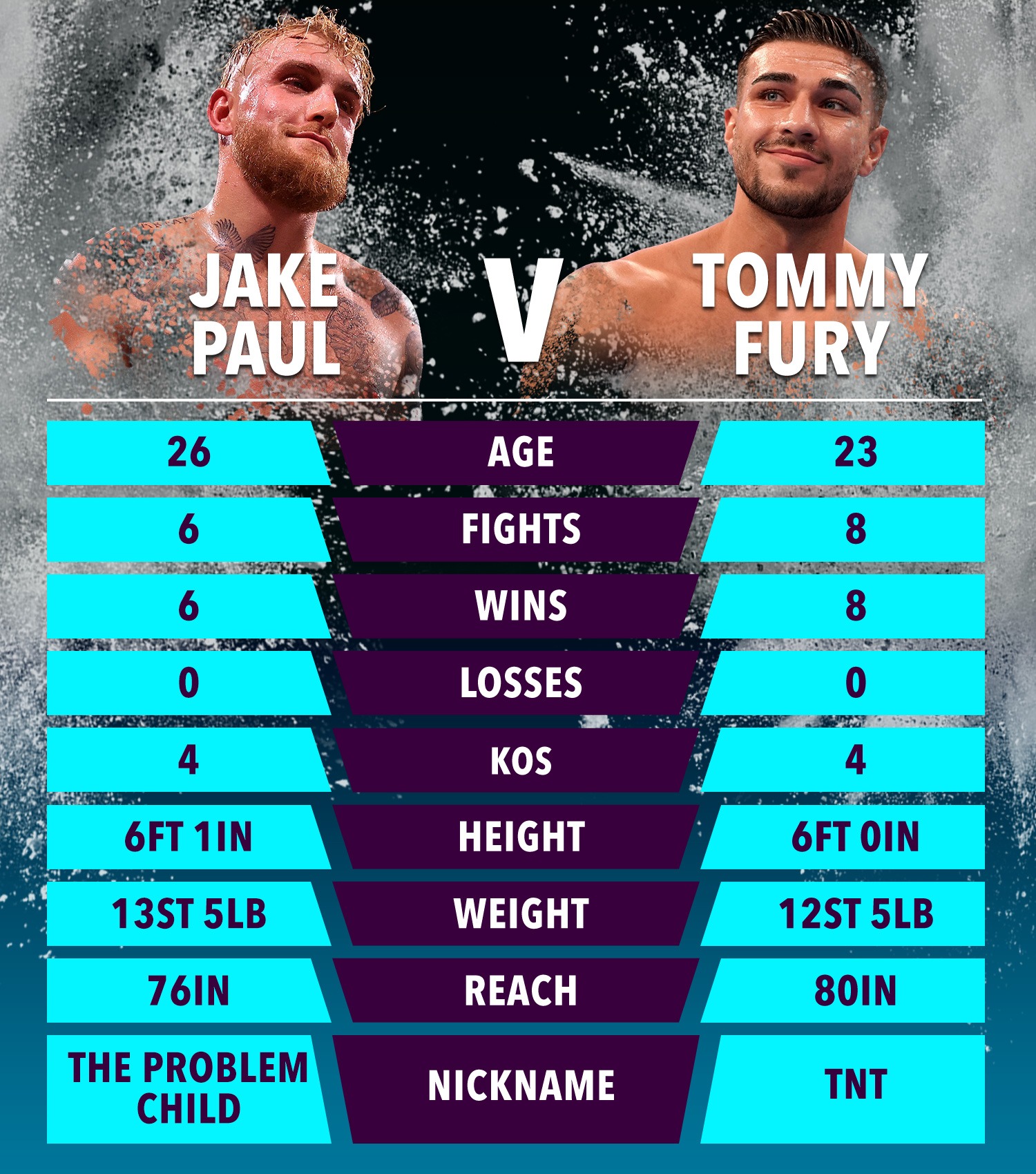JAKE PAUL has been urged by his ex-coach Shane Mosley to fight a former world champion if he beats Tommy Fury.
Mosley, who won titles in three divisions, was the first to ever train Paul as a professional.
Shane Mosley pictured with Jake Paul
Jake Paul, Derek Chisora and Tommy Fury
He led the YouTuber-turned boxer to a one-round victory over YouTube rival AnEsonGib in January 2020.
But Paul, 26, is now trained by ex-cruiserweight contender BJ Flores and Danny Smith, since going 6-0.
He returns on Sunday in Saudi Arabia against Tommy Fury, 23, with the victor earning a WBC cruiserweight world ranking.
In his last fight, Paul beat Anderson Silva, 47, the UFC legend who in 2021 defeated ex-middleweight champ Julio Cesar Chavez Jr, 37.
And it is the son of Mexican boxing legend Chavez Sr who Mosley wants Paul to face after Fury.
He told FightHype: “Maybe he should fight Chavez Jr or something, or he fights this guy [Tommy Fury] and he wins, then fight Chavez Jr.
“Anderson Silva fought him already, maybe he should fight him and see what happens.
“He has to step his way up, keep stepping his way up and the way he looks now, he can do it.

“The way he is training now, continue to train, continue to believe, yeah, why not?”
Fury will be the first opponent of Paul’s with a recognised boxing record.
That is despite wins over ex-MMA champions Ben Askren, 38, Tyron Woodley, 40, and Silva.
So the WBC’s decision to potentially rank the YouTuber-turned boxer caused outrage.
But Mosley believes Paul has the tools to take it all the way eventually, but suggested a move down to light-heavyweight.
He said: “It is a possibility, because he has the frame, he has the speed, he has the power.
“He might need to lose a little bit of weight, but he fights at cruiserweight so maybe he goes down to light-heavyweight.
“It is going to be hard for him at any of the weights, once you get to that level, then he has got to work with the right people.
“But, like right now, it will probably take him, two, three, four years to even be in that section, that area.
“He is not there yet, but if he fights the right people, then maybe he can do it.”

Julio Cesar Chavez Jr lost to UFC legend Anderson Silva
Frequently Asked Questions
How many punches does a human take to get through a round?
A punch is defined by “a blow delivered using a fist”. A punch can only be taken once per person. When someone hits you in the face, he/she is punching you. You can’t hit them/her back. This would be two punches.
Can I train boxing without fighting?
You can’t train boxing without fighting. To improve your boxing skills, you must work hard. You will be able to improve your boxing technique and endurance.
It is important to observe good boxers fighting in order to improve your boxing technique. The first step towards improving your boxing technique is to watch some good fighters. Watch their moves, how they throw the punches, and how you defend yourself. Try to imitate their movements.
Next, you’ll have to spar against another opponent boxer. This is where you will see if your boxing technique has improved. You will also be able to see how fast you punch, how strong your punches are, and how well it blocks incoming punches when sparring.
Finally, practice your boxing skills with drills. You will improve with practice so be patient and persevering.
How do I practice boxing alone?
If you’re looking for a partner to practice boxing, you can watch boxing matches on television. A local amateur boxing association is also available. Amateur boxesing clubs usually hold regular training sessions. These sessions often involve sparring partners who hit the pads together.
Punching bags are another option for practicing boxing. Before you hit the bag, make sure to wear protective gear like boxing gloves.
What are the advantages of boxing?
There are many health benefits associated with boxing. For starters, boxing helps build strong muscles and bones. It enhances your coordination as well as reflexes. It also strengthens your heart and lungs. The best part is that boxing doesn’t require any special equipment. You can use anything you have lying around the house.
How long does it take to become a professional boxer?
Professional boxing requires years of dedication and hard work. A minimum of 10 hours per week is required to train to become a professional ring fighter.
What are the 7 punches used in boxing?
The seven punches used in boxing include the jab (cross), hook, uppercut; straight right; left hook; and body shot. These punches are used for attacking the opponent’s body, head, and legs.
How to defend yourself:
Always defend your head when you’re being attacked. It is your goal to not get punched. To do so, you need to know how to block an incoming punch. Here’s the way to do it.
- Stand tall and square yourshoulders.
- Keep your elbows near your sides.
- Block the incoming punch by using your forearm.
- Counterattack immediately.
- Keep blocking until the attacker flees.
- Don’t give up on your defense.
Statistics
- You want to be running at roughly 75-80% of your top speed..5 mile slow, easy recovery jog at the end.[6]X Research source 2Mix in long runs, shadow boxing, and short sprints on non-interval days. (wikihow.com)
- It is just like normal sparring with a partner, but you want to throw punches at 75% of your normal speed. (wikihow.com)
External Links
boxandflow.com
expertboxing.com
How To
These are the basics of boxing
How to box effectively
Boxing has become a very popular sport. It consists of two opponents who try to knock out each other’s head. Each country has its own rules. There are three main types of boxing: Amateur boxing, Professional boxing, and Olympic boxing.
Amateur boxing can be practiced at school or college. This boxing style includes sparring sessions without protection, using padded gloves. Amateur boxing competitions typically last for three rounds, each lasting five minutes. There are many styles to amateur boxing like Kickboxing. Muay Thai. Taekwondo. Karate. Judo. Wrestling.
Professional boxing is usually practiced in gyms, clubs or stadiums. They wear protective equipment such as mouthpiece, nose guard, shin guards, elbow pads, knee pads, waist belt and groin protector. Professional boxing contests last six rounds and last for four minutes each. There are several different styles of professional boxing including Boxing, MMA (Mixed Martial Arts), Kickboxing, Muay Thai, Taekwondo and others.
Olympic boxing can be seen at the Olympics. International standards require that boxers use special protective gear. The competition lasts for eight rounds, each lasting three minutes. Olympic boxing can be divided into two types: Light Flyweight (Heavyweight) and Heavyweight (Light Flyweight).
The basic skills of boxing are:
- Punching techniques
- Guarding techniques
- Footwork
- Stance
- Movement of the body
- Defense
- Combination
- Rotation
- Spare parts
Punching Techniques
There are seven types of punches available: Left Hook and Right Hook, Cross, Cross, Straight, Underhand, Overhand, Cross, Straight, Cross, Straight, Cross, Straight, and Overhand. Each punch has its own technique. Some punches require greater strength than others. For example, an uppercut requires great force. On the contrary, a straight punch takes less power but is faster than most punches.
There are also various punching combinations. These are combinations which combine several punches in order to achieve a specific goal. A combination can contain multiple parts. A left hook followed with a right-cross will cause injury to the opponent’s jaw.
Guard Techniques
A boxer uses his body to protect himself against attacks. He does this by using his legs, arms, elbows, hands, knees and feet.
Legs
Boxers should use their legs to defend against kicks. He raises his leg when he is hit with a kick and then moves away from the opponent. To avoid being kicked on his side, he will bend his knees if the attack is from the front. But if the attack comes in the back, he will stand straight and block the kick using his foot.
Elbows
Elbow strikes are very powerful because they inflict great pain. You can deliver an elbow strike directly or indirectly. Directly refers to hitting your opponent with the forearm, while indirect means you hit him using another part of your arms.
Hands
Boxers use both their hands and arms to prevent incoming blows. They raise their fists high above their heads and point them in the direction of an attack. Then they make contact with the attacker’s fist.
Knees
Boxers should bend their knees when receiving blows to the abdomen, stomach, or chest. A lot of boxers use knee strikes to defend themselves.
Feet
A boxer should not be afraid to respond to an attack. This will help him gain distance from his opponent. In addition, when delivering a counter-attack, a boxer should keep his balance.
Stances
Boxing effectively requires a boxer to have a good stance. The way he defends him will be dictated by his stance. It defines where he faces his opponent and how he positions his body. Boxers have many options for stances. These are the most popular:
- A low stance
- High stance
- Southpaw stance
- Western stance
Move your body
Boxers must maneuver around their opponent to win fights. This includes changing speed, position and rhythm.
Rotation
Boxers rotate their arms when they throw a punch. Depending on the type and size of punch, the speed at which the rotation takes place varies.
Combinations
The timing of each individual punch affects the effectiveness or failure of a combination. A combination that is effective starts with a strong punch, and ends with one that is weak.
Spare parts
Sparring is a form of boxing that aims to improve your skills. During sparring sessions, a boxer trains his mind as well as his body. The goal of sparring is to learn to fight, and not to get hurt.
Learning to box takes dedication and patience. You need to train hard and long in order to become a better boxer.

